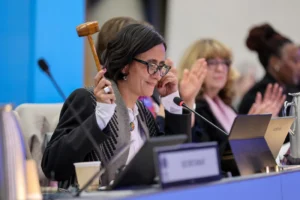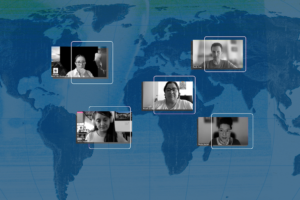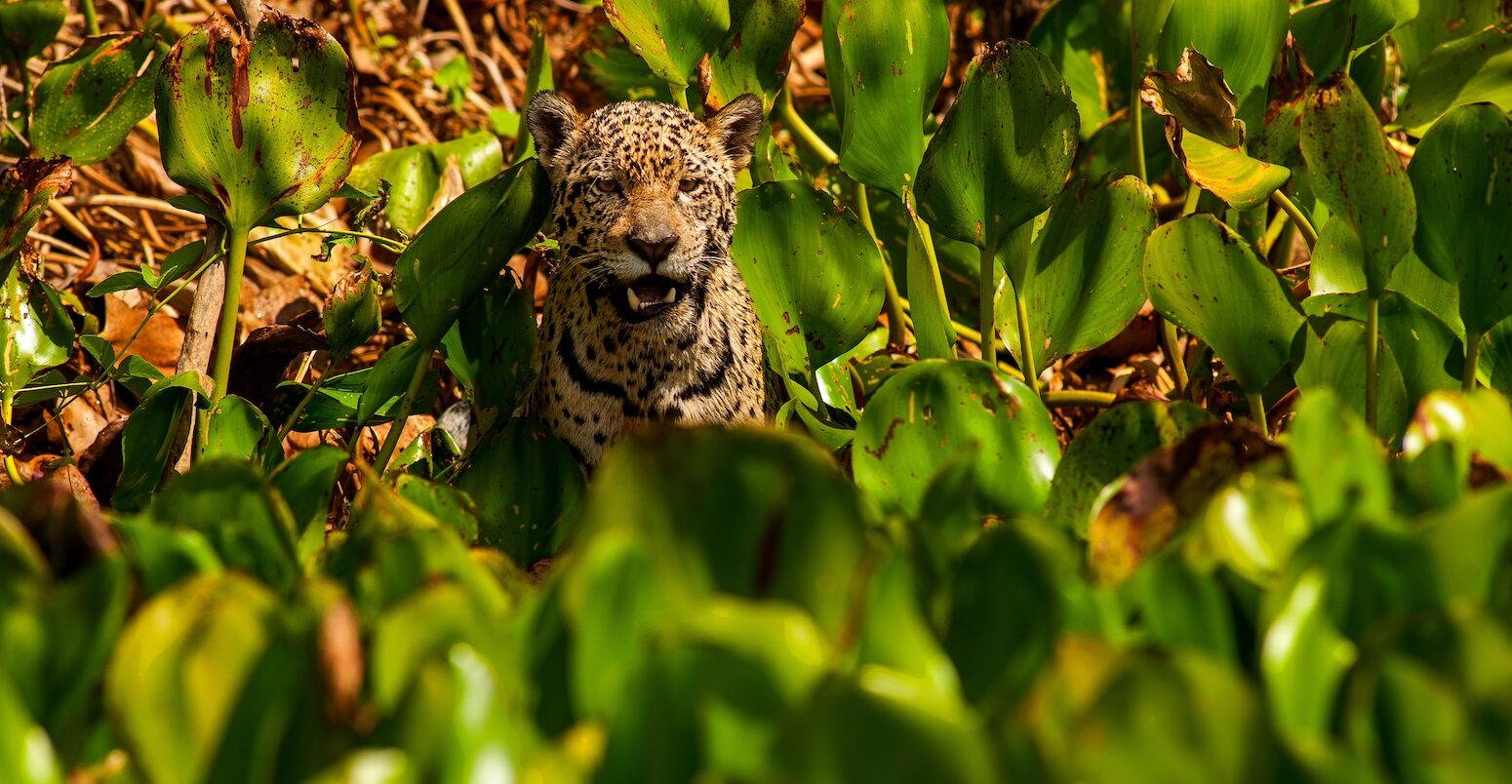
Developed countries failing to pay ‘fair share’ of nature finance ahead of COP16
Aruna Chandrasekhar
10.18.24Aruna Chandrasekhar
18.10.2024 | 2:23pmThe majority of developed countries are paying less than 50% of their “fair share” towards biodiversity finance, according to new analysis.
These nations contributed less than $11bn in total in 2022, the year that a landmark global nature deal, known as the Kunming-Montreal Global Biodiversity Framework (GBF), was agreed at COP15.
Taking into account the historical responsibility for biodiversity loss over the past 60 years, the London-based development thinktank ODI has calculated a “fair share” for each country towards a minimum collective target agreed in 2022 aimed at raising $20bn annually by 2025 for biodiversity conservation.
In 2022 – the most recent year for which data is available – only Norway, Sweden and Germany contributed their “fair share”, the analysis shows. The UK, Italy and Canada – host of the COP15 biodiversity summit, where the deal was struck – each contributed less than 40% of their share.
Japan was the “worst performer in absolute terms”, falling short of its fair share by $2.4bn in 2022 and “will need to at least triple its biodiversity finance” by 2025, ODI says.
“These big economies continue to drop the ball on biodiversity finance,” Sarah Colenbrander, co-author and ODI director of climate and sustainability, tells Carbon Brief.
Additionally, pledges to a separate “framework fund” established at COP15 have amounted to less than $250m, with Japan yet to pay a single yen of the ¥650m ($4.47m) it had pledged to the fund.
With COP16 set to start in Cali, Colombia, next week, Carbon Brief looks at the progress towards meeting the GBF’s finance targets, what constitutes a “fair share” and what needs to happen to fund nature conservation over the decade ahead.
What was agreed on finance at COP15?
At COP15 in 2022, 196 countries agreed to an ambitious global deal to reverse biodiversity loss by 2030, dubbed the Kunming-Montreal Global Biodiversity Framework (GBF).
The “Paris Agreement for nature” was gavelled through despite objections from developing countries, with parties given little time to examine the fine print on how these targets would be financed.
The GBF has a target to mobilise “at least $200bn per year” for biodiversity conservation by 2030 from “all sources”– domestic, international, public and private.
Of this, developed countries – along with others that “voluntarily assume” their obligations – are expected to “substantially and progressively increase” their international finance flows for nature “to at least $20bn per year by 2025, and to at least $30bn per year by 2030”, the GBF text states.
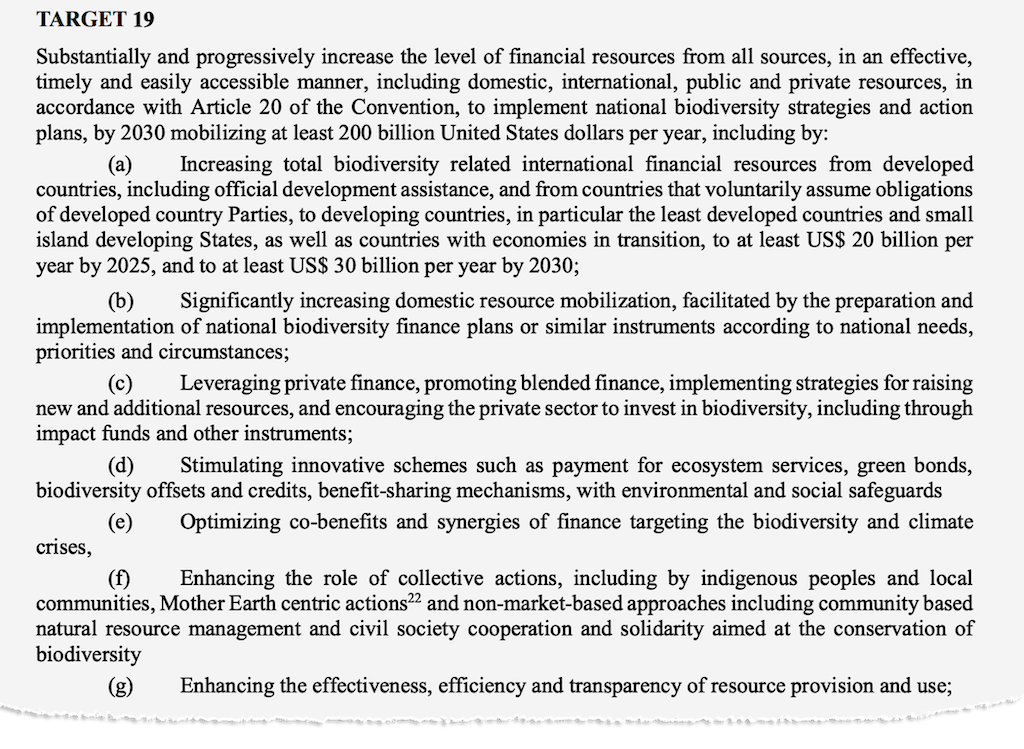
The $20bn target has attracted criticism from developing countries.
One objection is the amount, given that the biodiversity “finance gap” – the shortfall between current funding for conservation globally and what is needed – is estimated at $700bn per year. The GBF states that countries must close this gap by 2030 through ending harmful subsidies ($500bn per year) and mobilising resources from the global north to south ($200bn per year).

According to Dr David Obura, chair of the Intergovernmental Platform on Biodiversity and Ecosystem Services, insufficient finance was a “primary factor in the failure to achieve” any of the Aichi biodiversity targets, which were agreed by nations in 2010, with rich nations raising less than $4bn a year in funds on average between 2015 and 2020.
In the run-up to COP15, developing countries demanded that developed countries increase their financial contribution to $100bn per year, mirroring the floor of climate-finance commitments up to 2025.
Another criticism is the collective nature of the target, along with little clarity on how it will be met. According to ODI, this approach “often shields wealthy nations from individual responsibility”.
Instead, apportioning individual responsibility can mitigate that risk and increase accountability and transparency, the authors say.
Are developed countries on course to meet nature finance goals?
There is no internationally agreed-upon definition of biodiversity finance. This can lead to confusing – and sometimes inflated – estimates of just how much countries have contributed to protect nature.
There are two main channels of international public finance that developed countries can use to meet their biodiversity finance commitments under the GBF: official development finance (ODF); and the Global Biodiversity Framework Fund (GBFF).
ODF combines bilateral “official development assistance” (ODA) and other official flows (OOF).
While these flows from developed to biodiversity-rich, developing nations are written into the UN Convention on Biological Diversity (CBD) to acknowledge historical responsibility for species loss, it was only in 2022 that countries agreed on the specific “$20bn by 2025” and “$30bn by 2030” targets.
The Organisation for Economic Co-operation and Development (OECD) is one of the main sources of biodiversity finance data on whether countries are meeting their funding targets. (Although it also acknowledges its own limitations and assumptions around what it counts as biodiversity finance.)
There are large differences in how much public finance is intended strictly for biodiversity (“biodiversity-specific”) and how much is intended for other projects where conservation is either a significant goal or a marginal co-benefit (“biodiversity-related”).
According to the OECD, developed countries – including the US – contributed $12.1bn towards biodiversity finance in 2022, an increase of 3% from 2021. However, biodiversity-specific funding – with the principal objective of reducing biodiversity loss – declined from $4.6bn in 2015 to $3.8bn in 2022.
As seen with climate finance, the form that this finance takes matters just as much as the quantity.
For example, the OECD says that some of these large donors have mostly used loans for biodiversity-related development finance, including France (87% of their contributions), Poland (85%), Japan (81%) and Canada (51%). Loans are seen as problematic by developing countries because they add to the debt burden that they are already facing.
The OECD also notes that the largest spike in biodiversity finance over 2015-22 was from development banks, mostly in the form of loans to already debt-distressed, but nature-rich nations. (See: Carbon Brief’s Q&A on debt-for-nature swaps.)
The figure below shows how different donors have contributed to what the OECD describes as an “all-time high” in development finance for nature in 2022.
With contributions from multilateral institutions alongside the biodiversity-related finance from developed countries, including the US, the total funding for biodiversity crossed $20bn in the year 2022.

How do each country’s contributions compare to their ‘fair share’?
One limitation of biodiversity finance data tracked by the OECD is that developed countries are often represented as a single unit, obscuring progress – or lack thereof – on a national level.
This, according to ODI, fails to reflect each country’s individual responsibility for biodiversity depletion. In order to better reflect countries’ roles, ODI has assessed each country’s “fair share” of the target of $20bn per year by 2025.
This calculation is based on each developed country’s specific ecological footprint between 1960 and 2021. (This “trade-adjusted footprint” accounts for a country’s consumption, including imports and exports, to give a more accurate picture of how consumption at home impacts biodiversity globally.) It also incorporates each country’s capacity to pay, measured by gross national income, and its population in 2022.
The chart below shows the biodiversity finance contributions of developed countries in 2022 against their “fair share” and the shortfall in meeting the GBF’s targets.
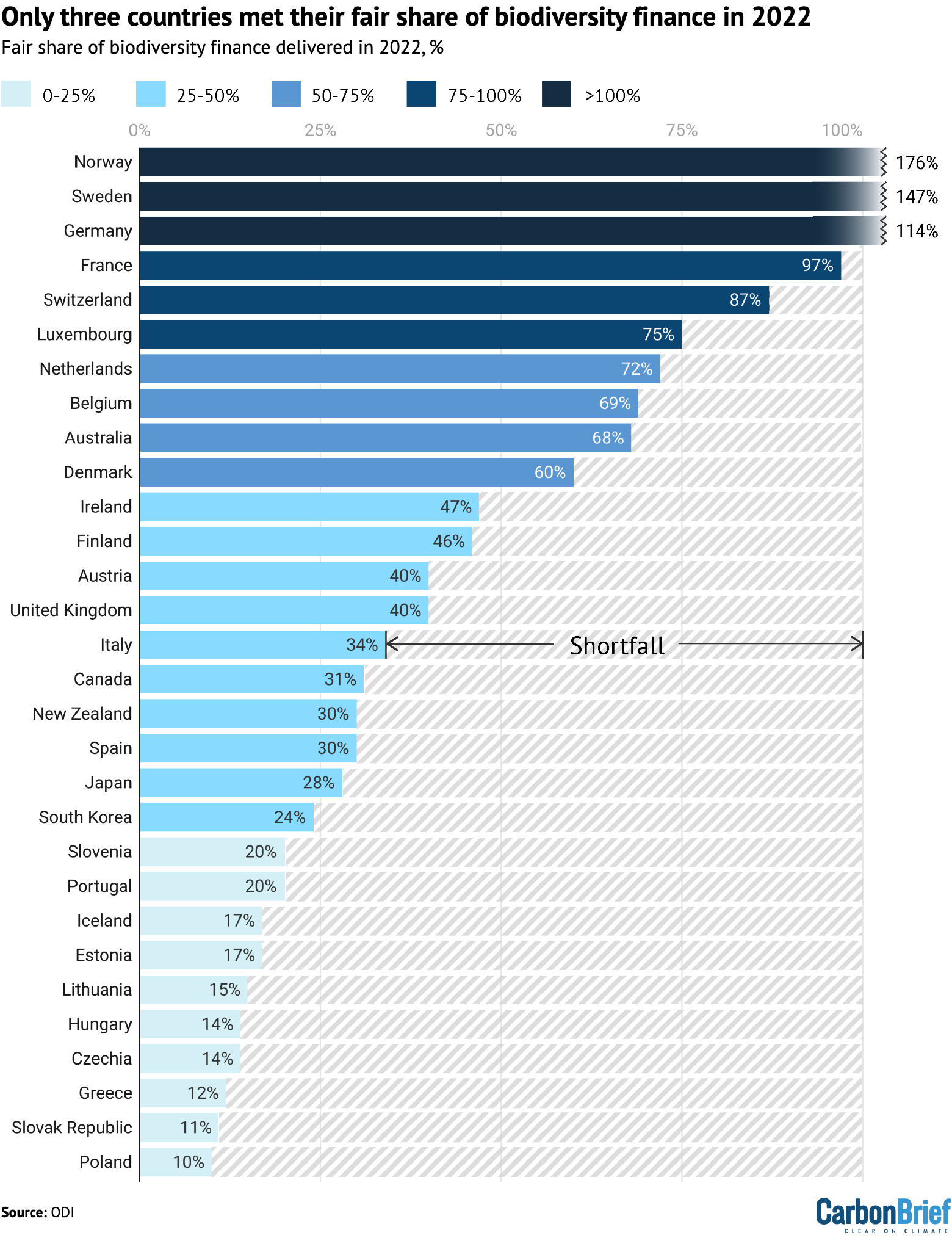
While ODI acknowledges that the $20bn is a fraction of the $700bn a year that biodiversity actually needs between now and 2030, it stresses that “this new data should spur a conversation around a delivery plan” for this sum.
Lead author and climate economist Dr Laetitia Pettinotti, who developed ODI’s “fair share” methodology, adds:
“There is an equivalent in climate finance, designed ahead of COP26 [in 2021] to catalyse further contributions, and there’s no reason why the same can’t be applied to this goal. Every year beyond the deadline is another year of deteriorating ecosystem services and declining biodiversity. These aren’t just numbers; this target matters to us all.”
The authors also acknowledge that their “fair-share” calculations do not take into account the “substantial biodiversity loss before 1961”, which “continues to contribute to less resilient ecosystems today”.
According to thinktank Third World Network (TWN), which was not involved in the report, using a 60-year cumulative ecological footprint “as a proxy for historical responsibility” does not fully reflect the “vast ecological debt” rich countries owe to poorer nations, “beginning since the colonial era”.
In a statement shared with Carbon Brief, TWN said:
“Calculating rich countries’ fair share of financing cannot be solely benchmarked against $20bn. $20bn per year was committed in the 2022 Kunming-Montreal Global Biodiversity Framework. The target is on a cumulative sliding scale – by 2025, the total provision should amount to at least $60bn, and increase thereafter to at least $30bn annually by 2030. This amounts to at least $210bn by 2030.”
The chart below shows how the target would accumulate per year, if “at least $20bn a year” was raised and then increased to $30bn per year until 2030.
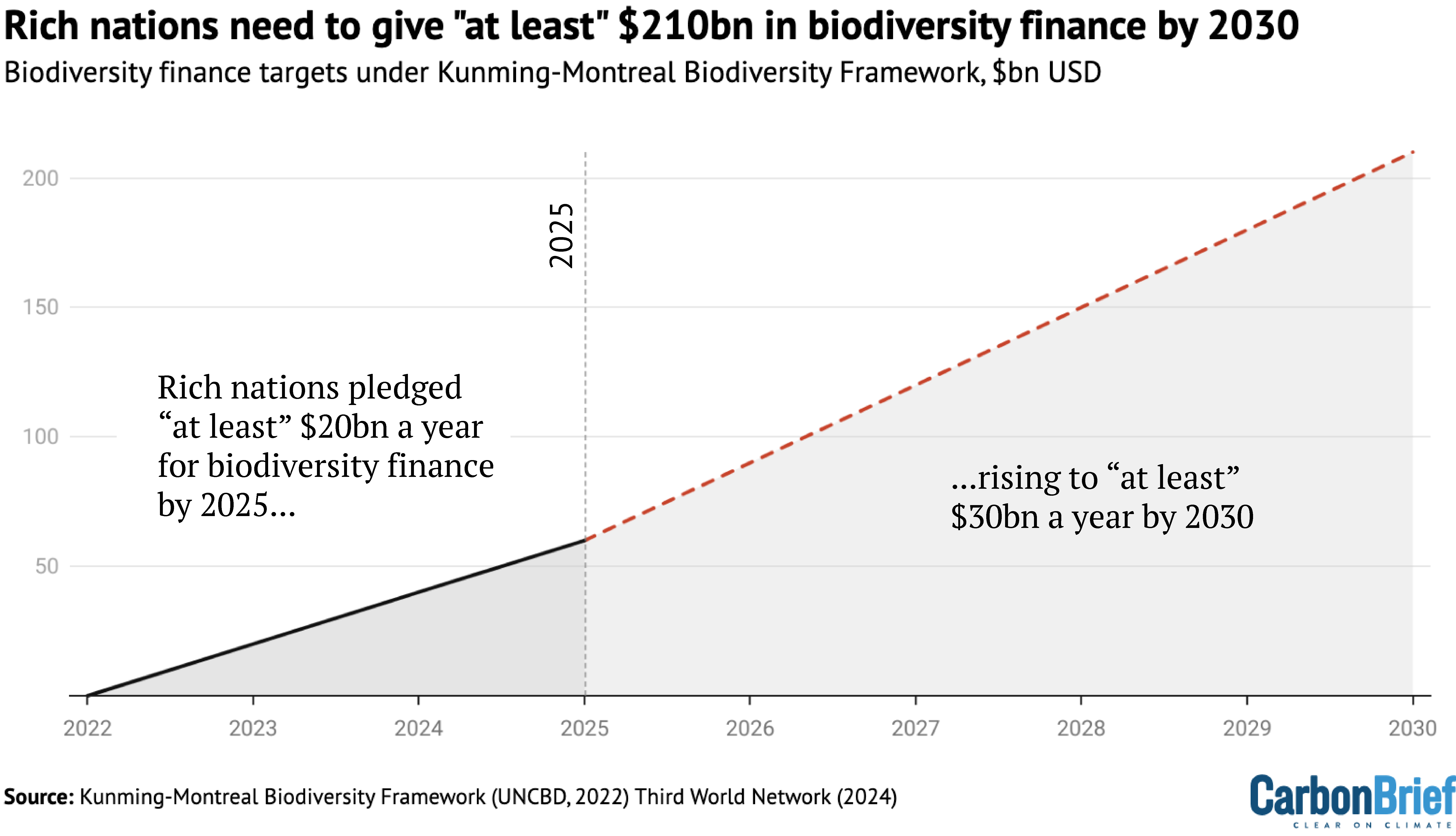
How much is being contributed to the Global Biodiversity Framework Fund?
The Global Biodiversity Framework Fund (GBFF) was established at COP15 in 2022 as another channel for countries and companies to contribute to the biodiversity finance target.
It is currently housed under the Global Environment Facility (GEF) – although developing countries continue to call for an entirely new fund governed by the COP.
Despite an initial flurry of pledges, rich nations have contributed less than $250m to the fund, as of 31 August this year, according to data the GEF has shared with Carbon Brief.
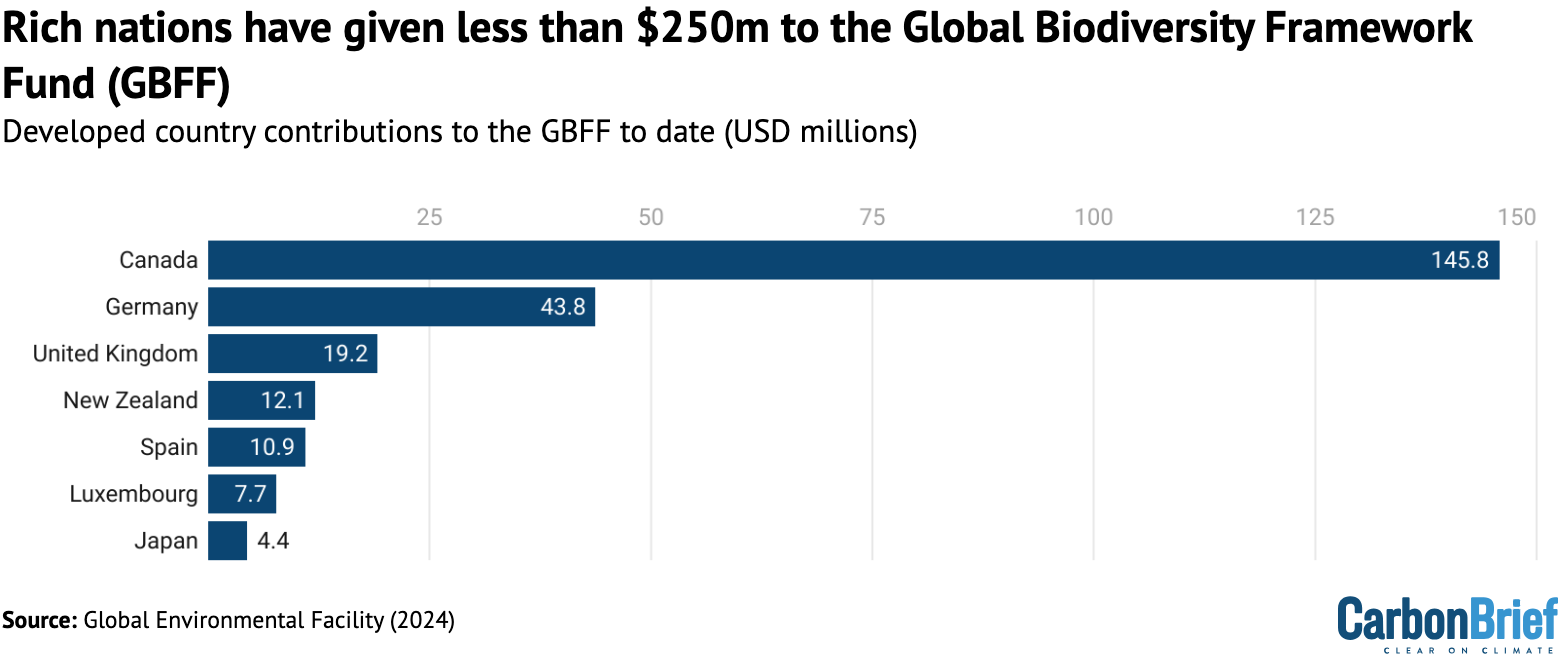
Additionally, according to the GEF data, Japan has yet to pay any of the¥650m ($4.4m) it has pledged to the fund, while Luxembourg has so far paid only $1.1m of the $7.7m it has pledged.
In August, COP16 president Susanna Muhamad urged global-north governments to “make a gesture to increase trust in the conference and actually put their money” into the GBFF to demonstrate their commitment.
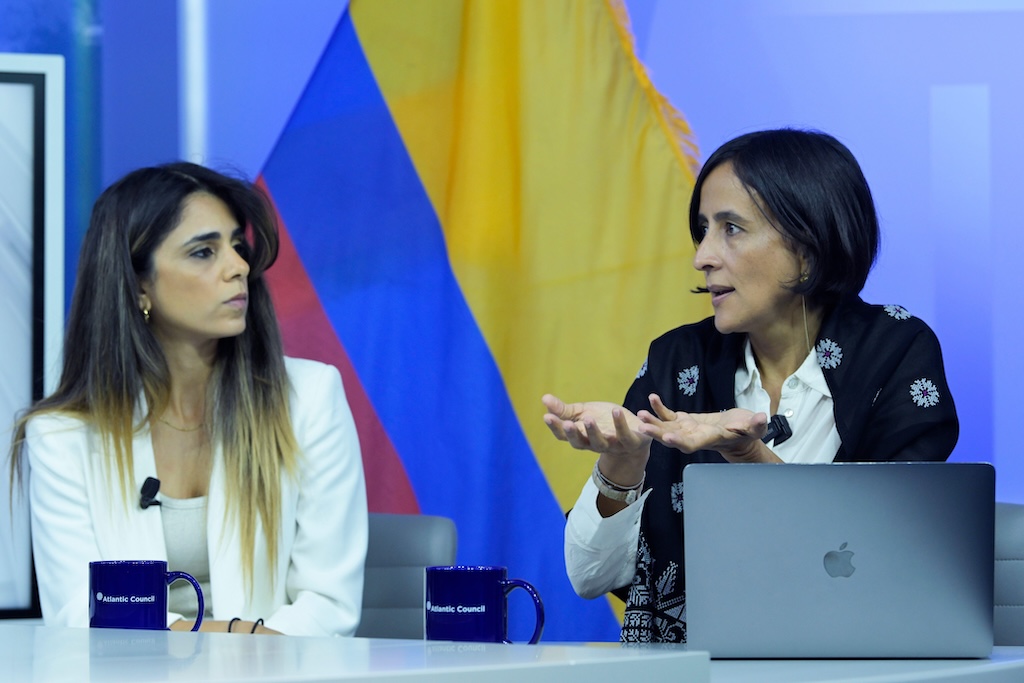
Unlike development finance flows, which can be hard to track and isolate, the GBFF publicly reports all of its financing to the COP and can clearly identify how countries are contributing to target 19.
Dr Chizuru Aoki, manager of the division of conventions and funds at the GEF, tells Carbon Brief:
“We welcome the commitment of the COP president to a successful outcome, including on resource mobilisation…Biodiversity needs much more funding [and t]he GEF is the heart of global finance for biodiversity and provides parties with an efficient and transparent vehicle to achieve target 19(a).”
While the fund has received no new pledges in recent months, according to Aoki, additional financial pledges are expected to be made during COP16.
Of the $244m received so far, the GBFF has already allocated more than half ($110m), with almost $40m going to four projects in Brazil, Gabon and Mexico. These include creating protected areas and sampling environmental DNA in Brazil’s Caatinga – the world’s largest semi-arid region, once home to the endangered Spix’s macaw.
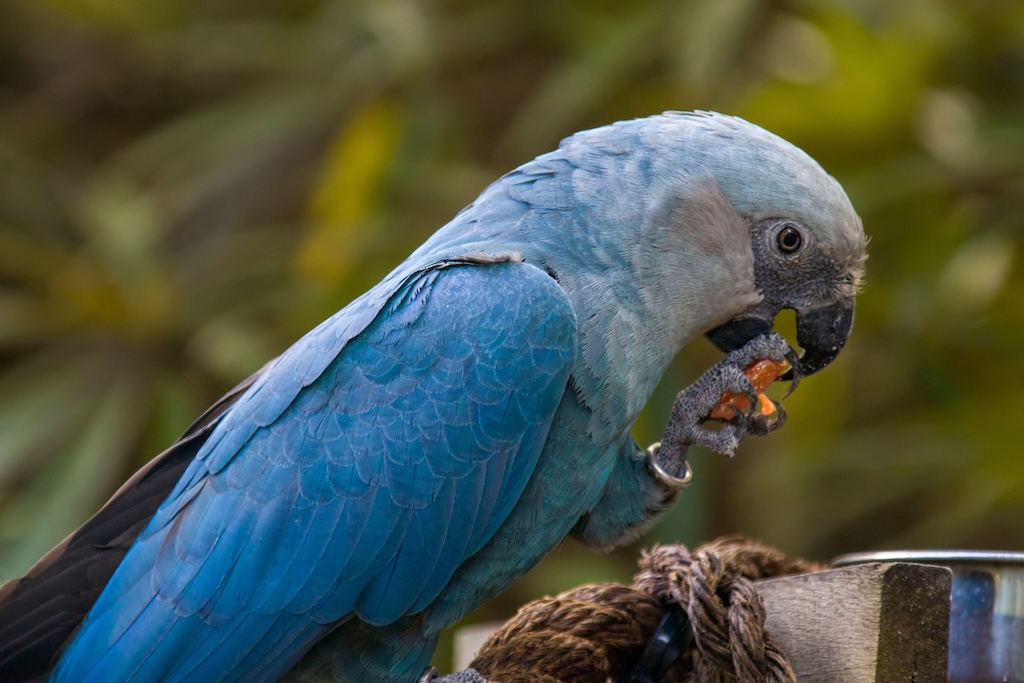
The fund has to allocate at least 36% of its resources to least-developed countries (LDCs) and small island developing states (SIDS).
It also has set an “aspirational target” of 20% of all its resources to go to Indigenous peoples and local communities.
However, new analysis by Indigenous rights campaign group Survival International points out that the fund is falling “far short” of this “aspiration” and “more than 50%” of all the money allocated so far will go through global-north environmental charities, such as WWF and Conservation International, to execute and implement projects in developing countries.
How has private finance contributed to meeting the nature finance target?
Target 19 also refers to “leveraging private finance” and “innovative schemes”, such as biodiversity offsets and credits, that will see an increased push and pushback at COP16. (See Carbon Brief’s in-depth Q&A on biodiversity offsets).
According to the OECD, private philanthropic flows for biodiversity grew from $501m in 2017 to $932m in 2021 and then decreased to $700m in 2022.
At the same time, private finance flows that have a direct negative impact on nature amount to $5tn a year, according to the State of Finance for Nature report.
Maelle Pelisson, the advocacy director for Business for Nature, tells Carbon Brief:
“Whilst it’s positive to see a growth in private philanthropies contributing to biodiversity finance, private philanthropy alone is not going to be sufficient to address nature loss…Governments should adopt and implement measures to ensure businesses include the value of nature in short- and long-term decisions, including requirements on disclosure and transition plans.”
The GBFF can receive contributions from private companies, with an expert group set up in June to advise the fund on issues that might arise, such as potential conflicts of interest. However, to date, no private companies have pledged contributions to the fund.
What are developing countries expecting to see at COP16?
Discussions on biodiversity finance in the run up to COP16 have been “difficult” and “polarised”, the Earth Negotiations Bulletin has reported.
In meetings on resource mobilisation earlier this year, developing countries “urged” rich countries to fulfil their commitments to close the biodiversity finance gap.
Many country groups continue to demand a separate global fund for biodiversity finance under the COP, distinct from the GBFF. (See: Carbon Brief’s interactive feature on who wants what at COP16.)
Developing countries have also called for a panel of experts to analyse “all financial flows” and “determine the extent to which parties have met their obligations under target 19”.
Both these suggestions remain heavily bracketed ahead of COP16 in Cali.
Nicky Kingunia Ineet, the DRC negotiator who had raised an objection before the gavel went down in Montreal, tells Carbon Brief:
“The creation of a special fund dedicated to biodiversity remains a sine qua non in the search for solutions linked to the mobilisation of resources in favour of biodiversity. This specific fund should be new, predictable and adequate, under the control and guidance of the COP, and accountable to it. The existing mechanism is provisional [and unfortunately] has not mobilised [the] resources as hoped.”
“Developed country parties should provide the necessary financial resources to developing countries to enable them to meet the additional costs of implementing the [CBD] and the GBF. This is wholly insufficient.”
Sarah Colenbrander, co-author of the report and ODI’s director of climate and sustainability, tells Carbon Brief:
“The US, Japan, Spain and Canada pride themselves on their countries’ natural beauty and their fantastic national parks, but these big economies continue to drop the ball on international biodiversity finance.”
-
Developed countries failing to pay ‘fair share’ of nature finance ahead of COP16



